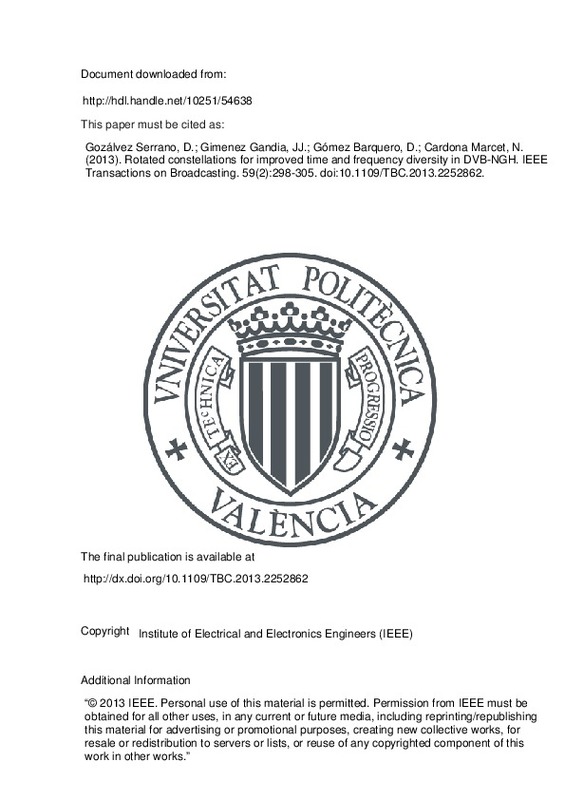JavaScript is disabled for your browser. Some features of this site may not work without it.
Buscar en RiuNet
Listar
Mi cuenta
Estadísticas
Ayuda RiuNet
Admin. UPV
Rotated constellations for improved time and frequency diversity in DVB-NGH
Mostrar el registro sencillo del ítem
Ficheros en el ítem
| dc.contributor.author | Gozálvez Serrano, David
|
es_ES |
| dc.contributor.author | Giménez Gandia, Jordi Joan
|
es_ES |
| dc.contributor.author | Gómez Barquero, David
|
es_ES |
| dc.contributor.author | Cardona Marcet, Narciso
|
es_ES |
| dc.date.accessioned | 2015-09-15T08:54:37Z | |
| dc.date.available | 2015-09-15T08:54:37Z | |
| dc.date.issued | 2013-06 | |
| dc.identifier.issn | 0018-9316 | |
| dc.identifier.uri | http://hdl.handle.net/10251/54638 | |
| dc.description | “© 2013 IEEE. Personal use of this material is permitted. Permission from IEEE must be obtained for all other uses, in any current or future media, including reprinting/republishing this material for advertising or promotional purposes, creating new collective works, for resale or redistribution to servers or lists, or reuse of any copyrighted component of this work in other works.” | es_ES |
| dc.description.abstract | In this paper, we investigate the potential gains that can be obtained with rotated constellations in DVB-NGH, the next-generation mobile broadcasting standard. Rotated constellations exploit the concept of signal-space diversity (SSD) to increase the diversity order of bit-interleaved coded modulation (BICM) at the expense of higher demodulation complexity without the need of additional transmission power or bandwidth. Two-dimensional rotated constellations (2DRC) were originally included in DVB-T2 (terrestrial second generation) to improve the reception robustness in fading channels. DVB-NGH inherits the same 2DRC from DVB-T2 and includes four-dimensional rotated constellations (4DRC) for certain configurations. Moreover, the standard has adopted a new component interleaver optimized for the utilization of rotated constellations with long time interleaving (TI) and time-frequency slicing (TFS). In this context, the additional robustness of rotated constellations is very interesting to counter the presence of signal outages in the time and frequency domains. To investigate the potential gains of 2DRC and 4DRC, we employ an information-theoretic approach based on mutual information, as well as physical layer simulations in DVB-NGH systems. The results reveal that rotated constellations are important to increase the diversity gains of long TI and TFS, and also to reduce the zapping time perceived by the users. | es_ES |
| dc.language | Inglés | es_ES |
| dc.publisher | Institute of Electrical and Electronics Engineers (IEEE) | es_ES |
| dc.relation.ispartof | IEEE Transactions on Broadcasting | es_ES |
| dc.rights | Reserva de todos los derechos | es_ES |
| dc.subject | Bit-interleaved coded modulation | es_ES |
| dc.subject | DVB-NGH | es_ES |
| dc.subject | DVB-T2 | es_ES |
| dc.subject | Rotated constellations | es_ES |
| dc.subject | Time interleaving | es_ES |
| dc.subject | Time-frequency slicing | es_ES |
| dc.subject.classification | TEORIA DE LA SEÑAL Y COMUNICACIONES | es_ES |
| dc.title | Rotated constellations for improved time and frequency diversity in DVB-NGH | es_ES |
| dc.type | Artículo | es_ES |
| dc.identifier.doi | 10.1109/TBC.2013.2252862 | |
| dc.rights.accessRights | Abierto | es_ES |
| dc.contributor.affiliation | Universitat Politècnica de València. Instituto Universitario de Telecomunicación y Aplicaciones Multimedia - Institut Universitari de Telecomunicacions i Aplicacions Multimèdia | es_ES |
| dc.contributor.affiliation | Universitat Politècnica de València. Departamento de Comunicaciones - Departament de Comunicacions | es_ES |
| dc.description.bibliographicCitation | Gozálvez Serrano, D.; Gimenez Gandia, JJ.; Gómez Barquero, D.; Cardona Marcet, N. (2013). Rotated constellations for improved time and frequency diversity in DVB-NGH. IEEE Transactions on Broadcasting. 59(2):298-305. doi:10.1109/TBC.2013.2252862 | es_ES |
| dc.description.accrualMethod | S | es_ES |
| dc.relation.publisherversion | http://dx.doi.org/10.1109/TBC.2013.2252862 | es_ES |
| dc.description.upvformatpinicio | 298 | es_ES |
| dc.description.upvformatpfin | 305 | es_ES |
| dc.type.version | info:eu-repo/semantics/publishedVersion | es_ES |
| dc.description.volume | 59 | es_ES |
| dc.description.issue | 2 | es_ES |
| dc.relation.senia | 247034 | es_ES |
| dc.identifier.eissn | 1557-9611 |







![[Cerrado]](/themes/UPV/images/candado.png)

